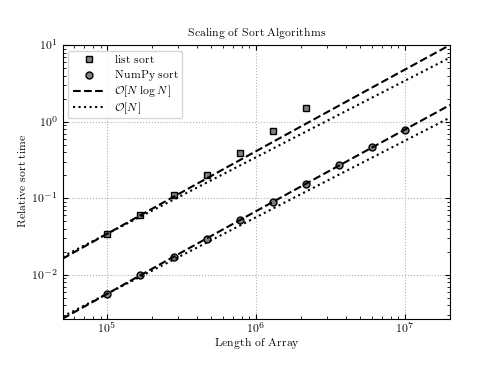Sort Algorithm Scaling¶
Figure 2.2.
The scaling of the quicksort algorithm. Plotted for comparison are lines showing O(N) and O(N log N) scaling. The quicksort algorithm falls along the O(N log N) line, as expected.

# Author: Jake VanderPlas
# License: BSD
# The figure produced by this code is published in the textbook
# "Statistics, Data Mining, and Machine Learning in Astronomy" (2013)
# For more information, see http://astroML.github.com
# To report a bug or issue, use the following forum:
# https://groups.google.com/forum/#!forum/astroml-general
from time import time
import numpy as np
from matplotlib import pyplot as plt
#----------------------------------------------------------------------
# This function adjusts matplotlib settings for a uniform feel in the textbook.
# Note that with usetex=True, fonts are rendered with LaTeX. This may
# result in an error if LaTeX is not installed on your system. In that case,
# you can set usetex to False.
if "setup_text_plots" not in globals():
from astroML.plotting import setup_text_plots
setup_text_plots(fontsize=8, usetex=True)
#------------------------------------------------------------
# Compute the execution times as a function of array size
# time quick-sort of a numpy array
N_npy = 10 ** np.linspace(5, 7, 10)
time_npy = np.zeros_like(N_npy)
for i in range(len(N_npy)):
x = np.random.random(int(N_npy[i]))
t0 = time()
x.sort(kind='quicksort')
t1 = time()
time_npy[i] = t1 - t0
# time built-in sort of python list
N_list = N_npy[:-3]
time_list = np.zeros_like(N_list)
for i in range(len(N_list)):
x = list(np.random.random(int(N_list[i])))
t0 = time()
x.sort()
t1 = time()
time_list[i] = t1 - t0
#------------------------------------------------------------
# Plot the results
fig = plt.figure(figsize=(5, 3.75))
fig.subplots_adjust(bottom=0.15)
ax = plt.axes(xscale='log', yscale='log')
ax.grid()
# plot the observed times
ax.plot(N_list, time_list, 'sk', color='gray', ms=5, label='list sort')
ax.plot(N_npy, time_npy, 'ok', color='gray', ms=5, label='NumPy sort')
# plot the expected scalings
scale = np.linspace(N_npy[0] / 2, N_npy[-1] * 2, 100)
scaling_N = scale * time_npy[0] / N_npy[0]
scaling_NlogN = (scale * np.log2(scale) * time_npy[0]
/ N_npy[0] / np.log2(N_npy[0]))
ax.plot(scale, scaling_NlogN, '--k', label=r'$\mathcal{O}[N \log N]$')
ax.plot(scale, scaling_N, ':k', label=r'$\mathcal{O}[N]$')
scaling_N = scale * time_list[0] / N_list[0]
scaling_NlogN = (scale * np.log2(scale) * time_list[0]
/ N_list[0] / np.log2(N_list[0]))
ax.plot(scale, scaling_NlogN, '--k')
ax.plot(scale, scaling_N, ':k')
# Create titles and labels
ax.set_title("Scaling of Sort Algorithms")
ax.set_xlabel('Length of Array')
ax.set_ylabel('Relative sort time')
plt.legend(loc='upper left')
ax.set_xlim(scale[0], scale[-1])
plt.show()
